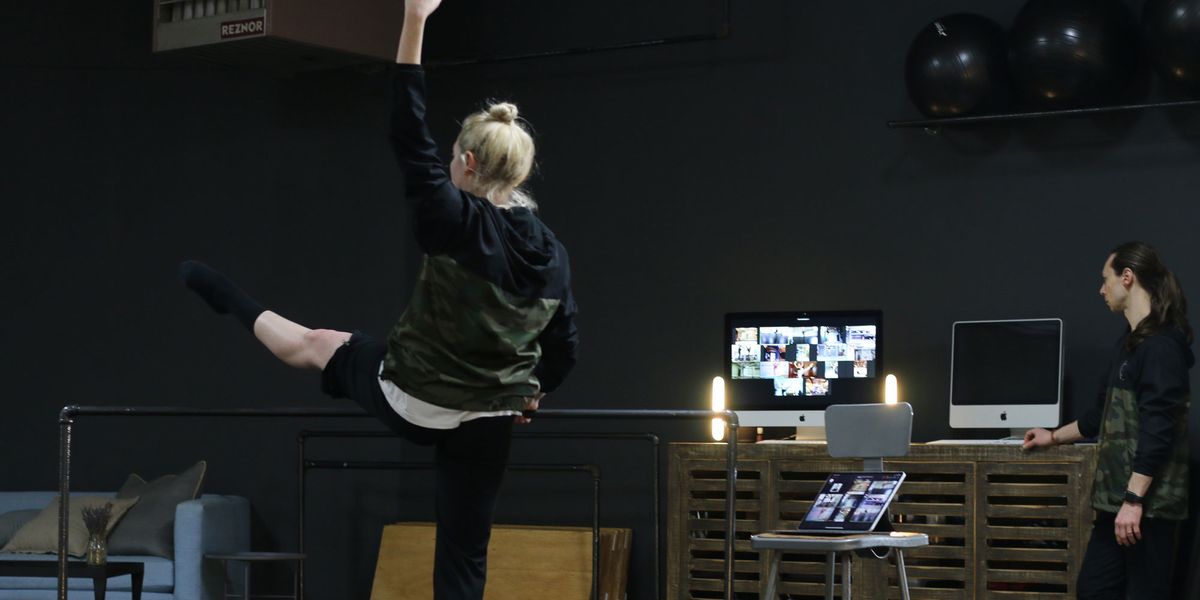The Dance Student's Guide to Making the Best—and the Most—of At-Home Training
If you’re social distancing to do your part to slow the spread of COVID-19, you’ve inevitably realized that training safely and successfully at home poses a significant challenge. We talked to dance experts to find out how you can make the best of this less-than-ideal scenario—and about the unexpected ways it can help you grow as a dancer and artist.
Create a Smart and Considerate Dance Space
If you don’t have a built-in dance space at home—and most of us don’t!—you’ll need to get creative to set up your makeshift studio. Clear as much open floor as possible, whether that means pushing your bedroom furniture to one wall or moving your dining room table to the living room (and moving it back when you’re done, of course). Avoid dancing on tile and cement floors if you can; those hard, slippery surfaces do your joints zero favors. But if they’re all you have to work with, Monique DeLuca, a physical therapist and performing arts fellow at Johns Hopkins Hospital, suggests wearing sneakers if possible while doing high-impact dancing.
And don’t forget about the backyard, if you’re lucky enough to have one. DeLuca says going outside to dance or exercise might be better than jumping on concrete in the basement. Just double-check beforehand to make sure it’s a level surface—watch out for holes, divots, roots, or anything you could roll an ankle on.
Tap Online Resources
First things first: If your dance school is hosting online classes, they’re your best bet by far. Following your own teachers’ plan is the most surefire route to success when training at home, since they know you and your technique needs better than anyone.
If your studio doesn’t have virtual classes—or if you want to sprinkle in some extra classes to keep that technique up—it’s worth looking into the options that many renowned schools, including Juilliard, and dozens of professionals are offering online for free. And if you’d like something a little more structured, there are also online training services like Veyette Virtual Ballet School or STEEZY to check out.

A Hive instructor corrects a student over Zoom (courtesy The Hive)
Expand Your Horizons
The many online options available right now present unique opportunities. Under normal circumstances, how many chances would you have to take a virtual barre from one of your dance idols? Or an IG Live class from that choreographer on the other side of the country that you’re obsessed with? When it comes to access, “It’s kind of an even playing field in the dance world right now,” says Seth Robinson, owner of The Hive studio in Chicago.
The anonymity of at-home training can be isolating, but it can also be freeing. Nobody’s watching you, so why not try a completely unfamiliar dance style? “Right now, you can dive in behind a screen and work on styles that you might not feel as fluid in,” Robinson says.
Track Your Progress
Dancers are used to constant group interaction, to hands-on corrections, and to the communal nature of class, which means training at home can feel like training in a vacuum. But even when your teacher isn’t there to hold you accountable, it’s essential that you continue to track your own progress. Otherwise, your technique will slide—quickly.
Make your phone camera your best friend (as if it weren’t already). Robinson suggests filming yourself every day during this remote training period. It can be as simple as setting your phone on a chair opposite you, hitting record, going through your daily barre, and then analyzing the footage each day. What mistakes are you making repeatedly? What bad habits need to be rooted out? Seeing yourself the way your teacher sees you might actually help you figure out why she was giving you those same corrections over and over again in the studio.
Take Care of Your Body
The bad news: You probably won’t be able to do a full grand allegro safely at home. The good news: This period of relative quiet is a good time to build a cross-training routine that will make you a stronger technician once you’re back in the studio, and help you avoid future injuries.
“Right now is an especially important time to be aware of overall health and wellness,” DeLuca says. Some of the most common issues she sees when treating dance patients stem from hip and core weakness. “I’d suggest working on hip strength, core strength, ankle stability, balance—all those things that you can do in a little bit of space, that don’t require a lot of movement,” she says.
DeLuca recommends strength and conditioning up to three times a week, including low-impact cardio like biking, if possible. Use your imagination to find substitutes for the equipment you might be lacking. Need to do your foot exercises, for example, but don’t have a Theraband at home? Robinson has a hack for that: “A basic dish towel or a washcloth will add some resistance.” And make sure you’re eating well and sleeping, since those factors can play a role in future injuries, too.

Zoom class at The Hive (courtesy The Hive)
Get Others Involved
Missing the dance family right about now? Make time to virtually connect with them, whether that means hopping on a Zoom class with your bestie or FaceTiming with your duet partner while you both take a virtual class. Better yet, rope your real family into learning whatever you’re working on—even if they’re not exactly dance pros.
“Get your parents involved, get your brothers and sisters involved,” Robinson says. “Because they’re going through the same hardships, and they’re going through the same feelings of missed energy and missed connections.” Dance it out together. It’ll be good for everyone’s physical and mental health.
Look for the Silver Linings
This new normal probably feels weird. And you’re probably daydreaming—a lot—about heading back to the studio. But remember that you’ll get out of this time what you put into it. It’s a chance to take responsibility for your own training—and learning how to do that will serve every dancer well in the long term.
“Everybody has the chance to soak up as much as they want. Everybody has the chance to diversify,” Robinson says. “What a perfect opportunity to fill your cup with things that you know bring you personal joy.”




